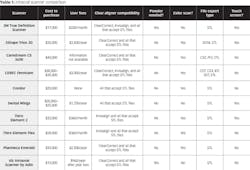Intraoral scanners: A review
Mike Meru, DDS
If you’re anything like me, you’ve seen the multiplicity of ads out there for intraoral scanners. You’ve heard the hype from different sales reps, spoken to colleagues with varying opinions, and wondered which scanner would be ideal for your practice. Maybe you’ve done some looking. If so, you know that things can get complicated. The scanner you like most may not upload files directly to your clear aligner manufacturer. Another may be half the price of the rest but have higher yearly costs and take longer to scan. With all the variables, how do you make the right decision?
There is no way I can tell you which intraoral scanner would be best for your situation, but having specific information can help. This article compiles the main attributes of each scanner and gives you important questions to consider. Hopefully it will assist you in finding your best solution.
Some of you may be debating whether to take the initial plunge into the intraoral scanning world, while others may be upgrading from earlier versions that are slower and clunkier. Either way, there are still common variables to consider, including patient comfort, scan time, portability, and accuracy.
I feel there are two overriding questions to consider prior to making this purchase. First, is the scanner compatible with your practice management software, lab, and clear aligner manufacturer? Second, does the cost structure make sense for the size and scope of your practice?
In recent years, lawsuits and market battles have shaped the direct compatibility of intraoral scanners with practice management software platforms and lab uploads. This means that although each scanner will provide excellent digital models and adequate accuracy, the ability to connect with your workflow may be compromised or nonexistent. Ask yourself these questions: Do you need your digital models to be seamlessly available chairside and during consults via your practice management software, or is connecting through another program sufficient? Does the scanner upload files directly and produce files that are compatible with the labs you use to manufacture appliances, retainers, and clear aligners? Can the scanner integrate with your current or future 3-D printer? When looking at a specific scanner, if the answer to any of these questions is no, I would recommend crossing that scanner off your list.
Let’s talk about cost now. You might think the price of intraoral scanners would be an easy collation, but the fees beyond the initial hardware and software sticker price can vary greatly. Get answers to these questions: What is the cost to store your models? Is there a recurring software or warranty fee? Is there an increased fee for using your scanner in multiple offices? While the initial sticker price or meeting discount may sound great, looking at overall cost structure as it relates to your practice is key to making a final decision.
If you were to search the internet and make a list of available scanners, it would be an incredibly long list. Many companies have moved into the dental space with this technology. That said, and despite the capability of many scanners to perform some orthodontic services, Table 1* focuses on the scanners that are orthodontic-specific and can serve as a platform to perform full-mouth scans, produce digital models, integrate with labs to produce retainers and appliances, and connect with at least one clear aligner manufacturer.
*Editor's note: Updated information regarding the Planmeca Emerald from the manufacturer is as follows: Cost = $30,000–$35,000; User fees = $0; Clear aligner capability = Please follow this link.
It’s now up to you! Take this information and discover which intraoral scanner can make your practice a more successful and enjoyable one.
Mike Meru, DDS, is in private practice in Salt Lake City. He is a diplomate of the American Board of Orthodontics, on the board of the American College of Dentists, a contributing editor to the Journal of Clinical Orthodontics, and the executive director of the Student Professionalism and Ethics Association. In his free time, he splitboards and spends time with his family.

